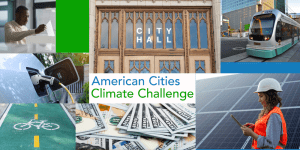4 ways cities are funding climate action

When President Biden signed the Inflation Reduction Act last week, city leaders heralded the new law’s massive investment in addressing climate change, including billions of federal dollars municipalities can tap into for climate projects.
Yet in some ways, the feds were just catching up to what cities have been doing on their own for years. City leaders were already moving urgently to slash greenhouse-gas emissions and find ways to pay for it when federal support was scarce.
“Mayors have long been at the frontlines of the climate crisis, doing what we can to move our communities and country closer to the Paris Agreement goals,” says Sylvester Turner, the Mayor of Houston and Chair of Climate Mayors, a group representing more than 470 U.S. mayors. “This bill will be an incredible boost to those efforts.”
Longtime leaders at the local level include the 25 cities who received support and resources from Bloomberg Philanthropies’ network of partners while participating in the American Cities Climate Challenge. The funding strategies these cities developed helped sustain American climate leadership in recent years and remain critical today, even with historic amounts of federal dollars flowing from Washington to cities.
Here are four ways the 25 cities that participated in the American Cities Climate Challenge are innovating around climate finance.
Unlocking long-term funding through ballot measures
In Denver, Mayor Michael Hancock won reelection in 2019 by focusing heavily on energy efficiency, solar power, and other climate solutions—but then he faced barriers in prioritizing and funding those objectives. Denver assembled a task force of community leaders, small-business owners, energy executives and other stakeholders to study existing efforts, identify primary targets for emissions reductions, and analyze funding options.
Building on this collaborative process, the City Council turned to voters to consider creating a funding mechanism. Ballot Measure 2A proposed increasing the local sales tax in a way that would raise about $40 million annually while placing most of the burden on tourists and other visitors to Denver. The funds would be distributed across programs such as solar panel installation, expanded e-bike access, home electrification work for older, less-efficient buildings, adaptation and resilience response, green jobs training, and more. Because the measure spoke to clear community needs—and because the community itself had a hand in the planning and execution—the measure passed with nearly 65 percent of the vote.
[Read: 9 cities that are leading on climate]
San Antonio city leaders also turned to voters—in their case to improve public transit. A ballot measure in 2020 proposed taking a one-eighth of a cent sliver of an existing local sales tax and reallocating it to mass transit. The measure won popular support and passed with 68 percent approval. With this revenue stream secured, San Antonio is now planning for additional bus lines to reduce stress on the existing transit system, starting in 2026.
These successful efforts not only created new funding streams for much needed work. They also created critical opportunities for city leaders to engage the public around the problem of climate change and build broad-based support for local solutions.
Rethinking the whole city budget
Faced with a tight budget for funding climate projects, Pittsburgh reworked the city budget itself.
City leaders partnered with budget specialists at ResourceX to use a tool known as “priority-based budgeting.” Essentially, they dropped the old way of budgeting around line items like “postage” or “paper” and replaced it with a system that’s focused on the outcomes the city wants to achieve. Hundreds of city programs and activities were scored according to whether they contributed toward the city’s goal of becoming carbon-neutral by 2050.
The result: Pittsburgh identified over $40 million in potential savings and new revenue that could be reallocated to meet the city’s climate goals—and established a more effective and strategic budgeting process for years to come. Because of this success, Pittsburgh is seeking further opportunities to expand the budgeting tool across other goals, such as equity.
“Changing budgeting procedures can feel like an enormous task,” explains Pittsburgh Climate Advisor Will Bernstein. “But in the end, the tools that were created actually streamlined work, while simultaneously making budget decisions clearer for the mayor’s office.”
Helping property owners to get financing
Local leaders aren’t just unlocking funds for city government to spend on climate projects. They’re also looking at ways to help local property owners finance the upfront costs of their own investments in energy-efficiency upgrades.
Atlanta and San Antonio, for example, are addressing a critical question some property owners face: What happens if I take out a loan to pay for insulation or a new energy-efficient HVAC system, but sell the property before the loan is paid off? These cities have enabled a new lending tool known as a “PACE loan” that attaches the loan to the property rather than the owner. If the property changes hands, the loan remains with the property until it’s repaid.
[Read: How U.S. cities are accelerating the switch to electric vehicles]
That’s important for several reasons. It encourages property owners to invest in energy efficiency without worrying about whether they’ll see a payback if they sell the property. It also allows lenders to set lower interest rates and longer repayment periods. San Antonio’s policy applies to energy-efficiency and water conservation retrofits of older commercial, industrial, and multi-family residential buildings. Atlanta’s program is focused on larger commercial properties, and is projected to finance as much as $200 million worth of energy-efficiency retrofits in 2023.
St. Petersburg, Fla., is trying a different approach. To accelerate residential energy upgrades, particularly for residents with low and moderate incomes, the city partnered with a nonprofit known as the Solar and Energy Loan Fund. The nonprofit helps residents build their credit and access loans that they may not be able to get from a traditional bank. The program has not only funded hundreds of energy-efficiency upgrades in homes around St. Petersburg but spread to other nearby cities, such as Tampa and Orlando.
Pulling down federal funds
Even with an influx of federal dollars available to U.S. cities through the American Rescue Plan Act, the Bipartisan Infrastructure Investment and Jobs Act, and now the Inflation Reduction Act, competition for federal funding is fierce.
Bloomberg Philanthropies and its partners have two programs that can help cities navigate the opportunities. At the Local Infrastructure Hub, U.S. city leaders can access technical assistance and a tool to find federal grant opportunities in the $1.2 trillion Bipartisan Infrastructure Investment and Jobs Act. At the Federal Assistance e311, city leaders can get answers to common questions they have about federal grant opportunities and requirements.
There’s lots cities can do to set themselves up for success. One is to align their plans closely to the Biden administration’s equity goals, laid out in the “Justice40” initiative. That’s what Albuquerque, N.M., has done by targeting support for residential energy-efficiency upgrades to low-income residents who benefit most from lower utility bills. That initiative caught the eye of U.S. Energy Secretary Jennifer Granholm, who visited last year to promote the program as an example other cities can learn from.
Another thing cities can do is coordinate closely with other local stakeholders to show they’re ready to collaborate. In Orlando, Fla., local leaders earlier this year convened representatives from all levels of government, as well as schools, research institutions, the airport, and others, to get on the same page about what infrastructure projects to pursue in the Orlando region. The approach of collaborating across sectors had already served Orlando well in rolling out a zero-emission bus-rapid transit system. They hope it will bear more fruit going forward.
“Partnerships are the only way forward,” says Chris Castro, who until recently was Orlando’s Director of Sustainability and Resilience. “If we approach these things in silos, we’ll never fundamentally transition toward a cleaner future.”

